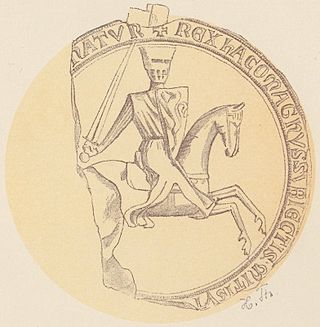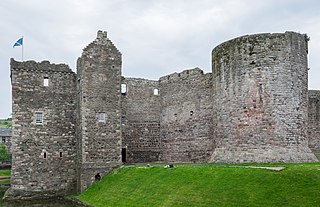Related Research Articles

Harald Fairhair was a Norwegian king. According to traditions current in Norway and Iceland in the eleventh and twelfth centuries, he reigned from c. 872 to 930 and was the first King of Norway. Supposedly, two of his sons, Eric Bloodaxe and Haakon the Good, succeeded Harald to become kings after his death.

Haakon IV Haakonsson, sometimes called Haakon the Old in contrast to his namesake son, was King of Norway from 1217 to 1263. His reign lasted for 46 years, longer than any Norwegian king since Harald Fairhair. Haakon was born into the troubled civil war era in Norway, but his reign eventually managed to put an end to the internal conflicts. At the start of his reign, during his minority, Earl Skule Bårdsson served as regent. As a king of the Birkebeiner faction, Haakon defeated the uprising of the final Bagler royal pretender, Sigurd Ribbung, in 1227. He put a definitive end to the civil war era when he had Skule Bårdsson killed in 1240, a year after he had himself proclaimed king in opposition to Haakon. Haakon thereafter formally appointed his own son as his co-regent.

The Kingdom of the Isles was a Norse-Gaelic kingdom comprising the Isle of Man, the Hebrides and the islands of the Clyde from the 9th to the 13th centuries AD. The islands were known to the Norsemen as the Suðreyjar, or "Southern Isles" as distinct from the Norðreyjar or Northern Isles of Orkney and Shetland. In Scottish Gaelic, the kingdom is known as Rìoghachd nan Eilean. The territory is sometimes called the Kingdom of Mann and the Isles, although only some of the later rulers claimed that title. The historical record is incomplete, and the kingdom was not a continuous entity throughout the entire period. At times the rulers were independent of external control, although for much of the period they had overlords in Norway, Ireland, England, Scotland or Orkney. At times there also appear to have been competing claims for all or parts of the territory. The islands have a total land area of over 8,300 square kilometres (3,205 sq mi) and extend for more than 500 kilometres (310 mi) from north to south.

Magnus Haakonsson was King of Norway from 1263 to 1280. One of his greatest achievements was the modernisation and nationalisation of the Norwegian law-code, after which he is known as Magnus the Lawmender. He was the first Norwegian monarch known to have used an ordinal number, although originally counting himself as "IV".
Haraldr Óláfsson was a thirteenth-century King of Mann and the Isles, and a member of the Crovan dynasty. He was one of several sons of Óláfr Guðrøðarson, King of the Isles, although the identity of his mother is uncertain. When his father died in 1237, Haraldr succeeded to the kingship as a fourteen-year-old, and held the kingship for about a decade afterwards.
Haakon III Sverresson was King of Norway from 1202 to 1204.
The Færeyinga saga, the saga of the Faroe Islands, is the story of how the Faroe Islanders were converted to Christianity and became a part of Norway.

Muircheartach Ua Briain, son of Toirdelbach Ua Briain and great-grandson of Brian Boru, was King of Munster and later self-declared High King of Ireland.
Haakon the Crazy was a Norwegian jarl and Birkebeiner chieftain during the civil war era in Norway. Håkon Galen was born no later than the 1170s and died in 1214. His epithet "the crazy" or "the mad" can also be translated as frenzied, furious or frantic and probably refers to ferociousness in battle.

Ogmund Crouchdance was a lendmann - a Norwegian noble in the 13th century and Sysselman (Governor) of Orkdal under the kings Håkon IV of Norway and Magnus VI of Norway. His nickname Crouchdance is probably derived from the name of a Norwegian medieval dance.
Magnús Óláfsson was a King of Mann and the Isles. He was a son of Óláfr Guðrøðarson, King of the Isles, and a member of the Crovan dynasty. Magnús' realm encompassed Mann and parts of the Hebrides. Some leading members of Magnús' family—such as his father—styled themselves "King of the Isles"; other members—such as Magnús and his brothers—styled themselves "King of Mann and the Isles". Although kings in their own right, leading members of the Crovan dynasty paid tribute to the Kings of Norway and generally recognised a nominal Norwegian overlordship of Mann and the Hebrides. Magnus was driven out by King Alexander III.

Hákonar saga Hákonarsonar or Hákonar saga gamla is an Old Norse Kings' Saga, telling the story of the life and reign of King Haakon Haakonarson of Norway.

Christina of Norway was the daughter of Håkon IV and his wife, Margaret Skulesdatter. She was born in Bergen. As part of an alliance she was betrothed to Philip, brother of Alfonso X of Castile. They married in 1258, and she lived in Castile until her death four years later. Tradition states that Christina desired that a church dedicated to St Olaf should be built in Castile. 750 years later, "a modernized version of [a] simple pre-Roman church" was built and dedicated in Covarrubias, Spain.

Rothesay Castle is a ruined castle in Rothesay, the principal town on the Isle of Bute, in western Scotland. Located at NS086646, the castle has been described as "one of the most remarkable in Scotland", for its long history dating back to the beginning of the 13th century, and its unusual circular plan.

Eóghan MacDubhghaill was a 13th-century Scottish nobleman and warrior who was styled "King of the Isles", "Lord of Argyll". He was the son of Donnchadh, son of Dubhghall, son of Somhairle mac Gille Brighde.

Haakon Haakonsson the Young was the son of king Haakon Haakonsson of Norway, and held the title of king, subordinate to his father, from 1 April 1240 to his death. He was referred to as Haakon the Young to distinguish him from his father, who was sometimes correspondingly called Haakon the Old.

Snorri Sturluson was an Icelandic historian, poet, and politician. He was elected twice as lawspeaker of the Icelandic parliament, the Althing. He is commonly thought to have authored or compiled portions of the Prose Edda, which is a major source for what is today known about Norse mythology and alliterative verse, and Heimskringla, a history of the Norse kings that begins with legendary material in Ynglinga saga and moves through to early medieval Scandinavian history. For stylistic and methodological reasons, Snorri is often taken to be the author of Egil's Saga. He was assassinated in 1241 by men claiming to be agents of the King of Norway.
Þórkell Þórmóðarson is a character from the mediaeval Hákonar saga Hákonarsonar, a kings' saga composed in the last half of the 13th century. The saga relates that in about the year 1230, a Norwegian-Hebridean fleet sailed down through the Hebrides, where it attacked certain islands there, and proceeded on to the Isle of Man. As the fleet made its way southward through the Hebrides, several members fought a battle with Þórkell at Vestrajǫrðr, near Skye. The exact location of Vestrajǫrðr is unknown, although Loch Bracadale, Loch Dunvegan, and Loch Snizort, all located on the western coast of Skye, have been proposed as possible locations. According to the saga, Þórkell and two of his sons were slain in the encounter, however a third son, named Þórmóðr, managed to escape with his life. Early the next year, the fleet headed northwards through the Hebrides back home. When it approached the Isle of Lewis, a man named Þórmóðr Þórkelson fled for his life, leaving behind his wife and possessions to be taken by the marauding fleet.
Óspakr, also known as Hákon, was a King of the Isles. He seems to have been a son of Dubgall mac Somairle, King of the Isles, and therefore a member of the Meic Dubgaill branch of the Meic Somairle kindred. Óspakr spent a considerable portion of his career in the Kingdom of Norway as a member of the Birkibeinar faction in the Civil war era in Norway. He seems to be identical to Óspakr suðreyski, a Birkibeinar who took part in the plundering of Hebrides and the sacking of Iona in 1209/1210. The context of this expedition is uncertain, although it may have been envisioned as a way of reasserting Norwegian royal authority into the Kingdom of the Isles.
Huldar saga is the name of a lost Icelandic saga said to have been told by Sturla Þórðarson in 1263. Though the saga is no longer extant, the account of its telling has attracted extensive commentary as a rare account of medieval Icelandic saga-performance.
References
- Þórðarson, Sturla; translation by G.W. Dasent (1894, repr. 1964) The Saga of Hakon and a Fragment of the Saga of Magnus with Appendices (London: Rerum Britannicarum Medii Ævi Scriptores, vol.88.4)
- Tordarson, Sturla (2008) Håkon Håkonssons saga (Thorleif Dahls Kulturbibliotek) ISBN 9788203193675